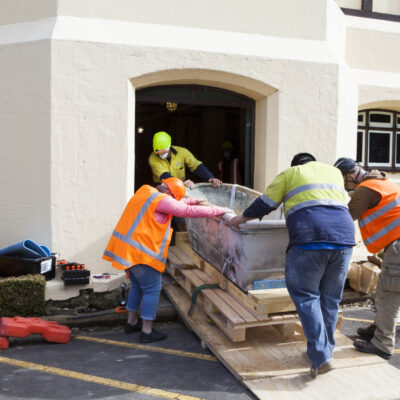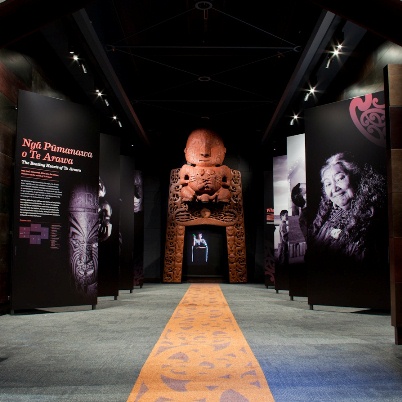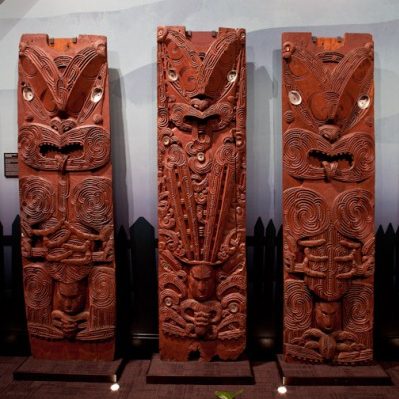Mud Bath Basement Removal
Must-See Exhibition
The Mudbath Basement was a must-see exhibition at Rotorua Museum. Visitors donned hard hats to head down underneath the historic building, ducking under pipes and past the boiler, to see the three original Royal Doulton ceramic baths – and one cast iron bath with a friendly bather!
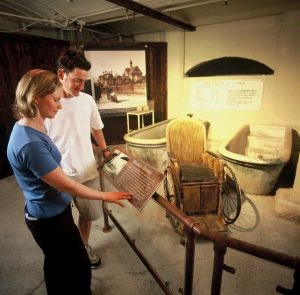
These original baths were used for medicinal mud bathing and have been in this location since the Bath House opened in 1908 as The Great South Seas Spa.
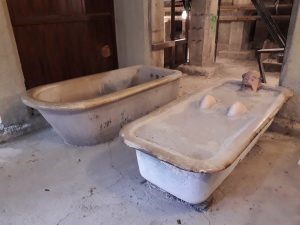
The Mudbath Basement was a must-see exhibition at Rotorua Museum. Visitors donned hard hats to head down underneath the historic building, ducking under pipes and past the boiler, to see the three original Royal Doulton ceramic baths – and one cast iron bath with a friendly bather!

These original baths were used for medicinal mud bathing and have been in this location since the Bath House opened in 1908 as The Great South Seas Spa.

Safely Stored
This slightly shocked gentleman, together with heritage baths and several other original bathing features, were moved into storage (end of July 2020) to prepare for the foundation works on the building.
Because of the importance of preserving and protecting these heritage objects, the removal process involved professional conservators, engineers, riggers and construction contractors Hawkins, working alongside our own Museum team to carry out this project.

Conservators, Detlef Klein and Marco Bürger visited the building in May 2020 to meet the Museum and construction teams and view the baths. With support from Heritage New Zealand and DPA Architects they then developed a detailed report setting out the relocation process including assessment of the weight and dimensions of each heritage element and most appropriate manner to move them. Detlef and Marco are very familiar with the Bath House building, having played an integral role in the planning and safe removal of the Summers’ Sculptures in 2017 and the large taonga in October 2018.
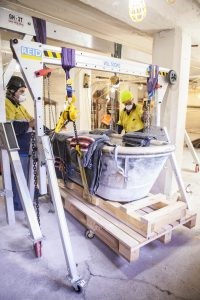
This slightly shocked gentleman, together with heritage baths and several other original bathing features, were moved into storage (end of July 2020) to prepare for the foundation works on the building.
Because of the importance of preserving and protecting these heritage objects, the removal process involved professional conservators, engineers, riggers and construction contractors Hawkins, working alongside our own Museum team to carry out this project.

Conservators, Detlef Klein and Marco Bürger visited the building in May 2020 to meet the Museum and construction teams and view the baths. With support from Heritage New Zealand and DPA Architects they then developed a detailed report setting out the relocation process including assessment of the weight and dimensions of each heritage element and most appropriate manner to move them. Detlef and Marco are very familiar with the Bath House building, having played an integral role in the planning and safe removal of the Summers’ Sculptures in 2017 and the large taonga in October 2018.

What was Removed?
The removal process began in mid-July and saw 60 items removed from the Mudbath Basement area.
Items included:
• 2x women’s Doulton baths weighing 464kg each
• 1x men’s Doulton bath weighing 332kg
• 1x cast iron bath with bather weighing 170kgs
• 1x mud vat – rusted sides required frame stabilisation before moving
• 1x wooden linen cupboard
• Walls and frame of nurses’ station
• Clay and cast iron pipes
• Wooden ceiling battens
• Contents of the strong room – a specialist paper conservator was onsite to remove the delicate paperwork including ledger pages and a diary along with an ink stand and ink wells
• Other treasures found were a brush from under the men’s Doulton bath, a cigarette packet hidden behind the cupboard, old towels from under the baths and a glass milk station bottle found in a room alongside ceramic tiles.
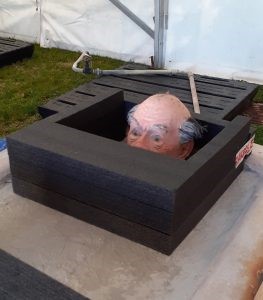
The removal process began in mid-July and saw 60 items removed from the Mudbath Basement area.
Items included:
• 2x women’s Doulton baths weighing 464kg each
• 1x men’s Doulton bath weighing 332kg
• 1x cast iron bath with bather weighing 170kgs
• 1x mud vat – rusted sides required frame stabilisation before moving
• 1x wooden linen cupboard
• Walls and frame of nurses’ station
• Clay and cast iron pipes
• Wooden ceiling battens
• Contents of the strong room – a specialist paper conservator was onsite to remove the delicate paperwork including ledger pages and a diary along with an ink stand and ink wells
• Other treasures found were a brush from under the men’s Doulton bath, a cigarette packet hidden behind the cupboard, old towels from under the baths and a glass milk station bottle found in a room alongside ceramic tiles.

The original time estimated for the removal process was two weeks however this was extended as all objects needed to be cleaned for asbestos prior to storage.
The baths will be kept in storage at the Museum offsite storage facility while construction works continue on the Bath House Building.


